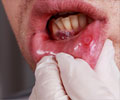Good news for those who have lost their eyesight because of injuries or burns. Researchers have found a new method of bringing back the sight by transplanting stem cells from one’s own oral mucous
Good news for those who have lost their eyesight because of injuries or burns. Researchers have found a new method of bringing back the sight by transplanting stem cells from one’s own oral mucous. Results of the research are so far promising, say scientists.
Stem cells are primal cells found in all multicellular organisms and they have the ability to renew themselves through cell division. The cells can also differentiate into a diverse range of specialised cell types.In the case of treatment of the eye, stem cells from the healthy eye are used for transplantation in the injured eye. If both the eyes are damaged, stem cells are taken from a donor. This is seen to cause infections, side effects on liver and kidney.
Patients also have to use drugs (immuno suppressants) for life long; the drugs cost about Rs 400 a day. City-based LV Prasad Eye Institute (LVPEI) has found an answer to this vexing issue for patients, and doctors too. The year-long research found an answer in the oral cavity.
LVPEI is close to commencing clinical trials on this new technique on patients very soon. The institute has been working on using stem cells for repairing the eyesight for the last four years. Several cases of partial and total blindness too are being handled using the stem cell research.
Stem cell scientist Yashoda Ghanekar and her team at LVPEI have developed the oral mucus solution that will throw light into the lives of two patients scheduled to undergo the transplant in a week.
'We have developed the technique over a year that could reconstruct ocular surface using stem cells from the patient’s oral cavity. This technique will be useful for patients who have lost limbal stem cells from both eyes,' Ghanekar says. Currently, such patients undergo ocular surface reconstruction using limbal cells from donor eyes, and are seen to develop immune-related problems and also face side effects of immuno suppressants.
Advertisement
According to Geeta V Vemuganti, head of stem cell laboratory and director of ophthalmic pathology service at LVPEI, the institute has since 2001 transplanted stem cells on over 500 patients, and the success rate has been 70 per cent. Her team is now exploring the advantages of using synthetic scaffold instead of amniotic membrane as a sheet to grow stem cells on it.
Advertisement
RAM/C








